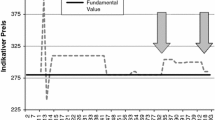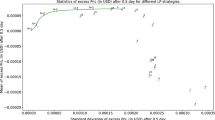Abstract
In this paper we explore the profit-taking tactics employed by informed traders when there are informational asymmetries across investors. Our laboratory is Tradesports, which until 2015 operated a double auction exchange where participants traded binary options contracts. This venue is a close analog to stock markets and, because each contract’s value is unambiguously revealed, the joint hypothesis problem is mitigated. We demonstrate that when the ratio of noise traders to sophisticated traders is highest, shares are most overpriced. Data show that informed traders heavily target noise traders when liquidity is high, and in conducting profit-taking operations they prefer to short sell via small transactions and round lots. Results suggest that, even in the absence of liquidity constraints and certain costs and risks related to short selling, the relative complexity of short selling can itself lead to overpricing.







Similar content being viewed by others
Notes
It is noteworthy that contracts are significantly overpriced in each of the first three price quintiles. Theories developed by Kahneman and Tversky (1979) and Prelec (1998) suggest that an s-shaped pattern should emerge with a point of inflection around $37, but here the point of inflection first occurs at around $66 (see Fig. 1).
Prior equity research has examined the informativeness of lot size rounding, and evidence suggests that round-quantity trades have greater price impact than do unrounded trades (Alexander and Peterson 2007).
References
Admati A, Pfleiderer P (1988) A theory of intraday patterns: volume and price variability. Rev Financ Stud 1:3–40
Alexander G, Peterson M (2007) An analysis of trade-size clustering and its relation to stealth trading. J Financ Econ 84:435–471
Avramov D, Chordia T, Jostova G, Philipov A (2013) Anomalies and financial distress J Financ Econ 108:139–159
Baker M, Wurgler J (2006) Investor sentiment and the cross section of stock returns. J Financ 61:1645–1680
Barclay M, Warner J (1993) Stealth trading and volatility. J Financ Econ 34:281–305
Bloomfield R, O’Hara M, Saar G (2009) How noise trading affects markets: an experimental analysis. Rev Financ Stud 22:2275–2302
Borghesi R (2007) Price biases in a prediction market: NFL contracts on Tradesports. Journal of Prediction Markets 1:233–253
D’Avolio G (2002) The market for borrowing stock. J Financ Econ 66:271–306
Engelberg J, Reed A, Riggenberg M (2012) How are shorts informed? Short sellers, news, and information processing. J Financ Econ 105:260–278
Grossman S, Miller M, Kenneth C, Fischel D, Ross D (1997) Clustering and competition in asset markets. J Law Econ 40:23–60
Harris L (1991) Stock price clustering and discreteness. Rev Financ Stud 4:389–415
Hodrick L, Moutlon P (2009) Liquidity: considerations of a portfolio manager. Financ Manag 38:59–74
Kahneman D, Tversky A (1979) Prospect theory: an analysis of decision under risk. Econometrica 47:263–292
Miller E (1977) Risk, uncertainty and divergence of opinion. J Financ 32:1151–1168
O’Connor P, Zhou F (2008) The Tradesports NFL prediction market: an analysis of market efficiency, transaction costs, and bettor preferences, 2008. Journal of Prediction Markets 2:45–71
O’Hara M, Yao C, Mao Y (2014) What is not there: the odd-lot bias of TAQ. J Financ 69:2199–2236
Prelec D (1998) The probability weighting function. Econometrica 66:497–527
Sadka R, Scherbina A (2007) Analyst disagreement, mispricing, and liquidity. J Financ 62:2367–2403
Schmeling M (2009) Investor sentiment and stock returns: some international evidence. J Empir Financ 16:394–408
Stambaugh, R, Yu J, Yuan Y (2012) The short of it: investor sentiment and anomalies. J Financ Econ 104:288–302
Subrahmanyam A (1991) Risk aversion, market liquidity, and price efficiency. Rev Financ Stud 4:417–441
Tetlock P (2008) Liquidity and prediction market efficiency. Columbia University, Working Paper
Wolfers J, Zitzewitz E (2006) Five open questions about prediction markets. University of Michigan and Dartmouth College, Working Paper
Author information
Authors and Affiliations
Corresponding author
Rights and permissions
About this article
Cite this article
Borghesi, R. Liquidity, overpricing, and the tactics of informed traders. J Econ Finan 41, 701–713 (2017). https://doi.org/10.1007/s12197-016-9375-5
Published:
Issue Date:
DOI: https://doi.org/10.1007/s12197-016-9375-5




